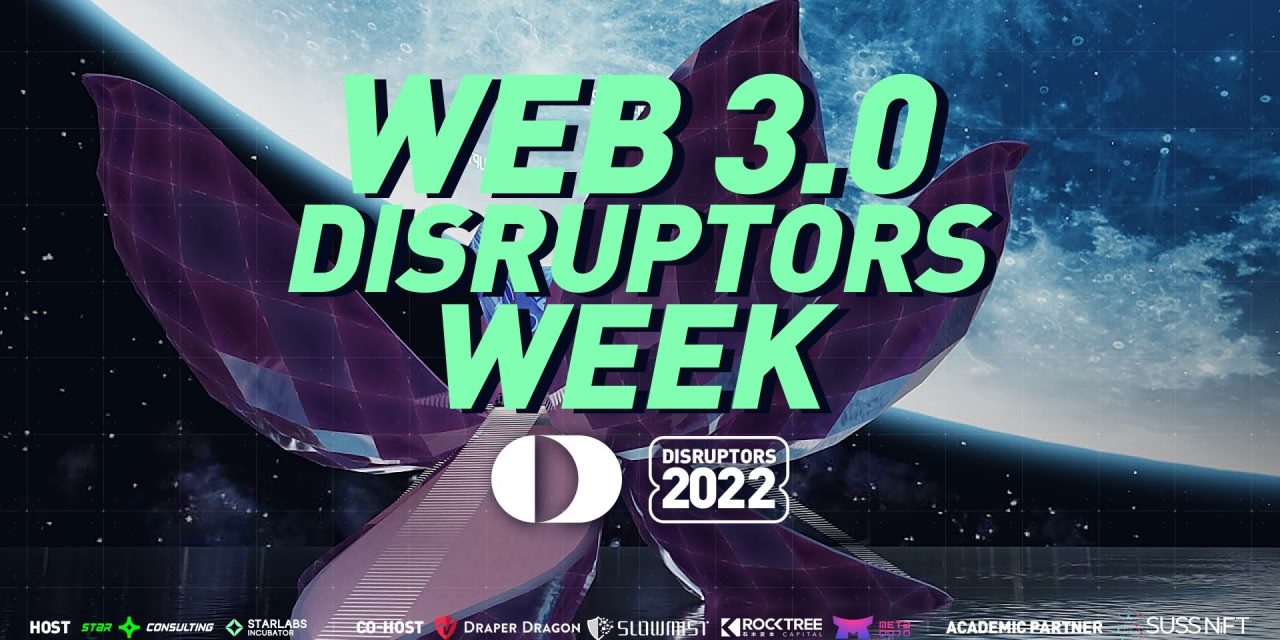Singapore – Building an internet that is better for us all comes as one of the consensuses for more than 30 blockchain pioneers at the Web 3.0 Disruptors Week that finished last month. This was the third summit of its kind hosted by Star Consulting and Starlabs Incubator. It was also the first time the event was live-streamed through a metaverse channel called “Meta Bloom”, a virtual stadium built by MetaDojo.
Leaders from the Digital Euro Associations, Singapore University of Social Sciences, Kasei Holdings and British Blockchain and Frontier Technologies Association, Greengage, Draper Dragon Fund, RockTree Capital, MetaDojo and Bit.Country and more have covered a wide range of topics.
These include how to ensure a responsible Web 3.0, the Web 3.0 mindset, the currency, the potential paradigm shift that comes with Web 3.0, investment, privacy and cybersecurity, gaming evolution, female disruptors and MetaFi.
Founder of Star Consulting and Starlabs Incubator, and curator of the annual Disruptors Summit, Jenny Yang, said there has been a lot of positive feedback about the event.
“Audiences have been telling us what those industry pioneers and experts shared was very timely and in-depth, which has helped deepen their understanding of Web 3.0, and inspired them in many ways too,” Yang said.
“It’s a true delight that our event has brought people inspiration and ideas and provoked reflections. This has always been what we wanted to achieve through our annual Disruptors Summit.”
A Responsible Web 3.0 Economy
In the very first session, speakers discussed how to build a responsible Web 3.0 economy. While acknowledging the benefits Web 3.0 could bring, they also expressed expectations and concerns for Web 3.0 builders.
Chair at Kasei Holdings and co-founder at British Blockchain and Frontier Technologies Association, Jane Thomason, said the industry needs to have a broader discussion not only about what people are building and what the unintended consequences are going to be but also on the broader issue around equity and social justice.
“A Web 3.0 that’s going to be accessible to all has to be on a mobile phone. You’re not going to have everyone wandering around the deserts in Mali with Oculus goggles on, so we have to think of the kind of infrastructure that you can build that’s going to make it much more accessible to more people and not further exclude people by making it infrastructure-heavy and expensive,” Thomason said.
Professor at Singapore University of Social Sciences (SUSS), David Lee Kuo Chuen, agreed and said providers need to do enough due diligence in the design thinking.
“All the collapse that we’ve seen in a lot of scams, they really think it will work but unfortunately there wasn’t enough discussion, and it was driven by more like how can I get my network out with the mass adoption with the prices going up the fastest as possible rather than having a positive impact on the society,” he said.
“It’s about time for all of us who are involved in the industry to call for very stringent action against those that misbehave.”
Executive Director at Digital Euro Association, Tamara Ferreira Schmidt, said involving some principles might work well to ensure an equitable and responsible Web 3.0 economy.
“First, start with self-determination. We know that early governance structures have largely instituted token-weighted voting, which the result being plutocracies and I think participants and builders of the Web 3.0 ecosystem need to push for a democratic system of governance that gives a voice to all its members not just a selected few so tokens could be distributed according to an algorithm designed to maximize diverse social clusters for example,” she said.
“The second principle I think is rewarding participation and not just capital, so Web 3.0 must have more ways to provide value to an ecosystem than through capital. Furthermore, that value should be able to be earned and not just purchased and this is a radical departure from the existing infrastructure but it’s an important step to ensure that everyone is on an equal footing and can attain positions of power and compensation through their own merit and contributions.”
Currency in Web 3.0
Analyst, derivatives trader and event producer Tone Vays said when he first heard about bitcoin, he thought it was interesting but it wasn’t interesting enough to scare him out of the current financial system and into bitcoin.
“There’s a whole other property of bitcoin that people very underestimate and that is the fact that bitcoin is the first unconfiscatable asset in human history,” he said, adding that it was very different from transferring it without a middleman,” he said.
“Whether it’s good or bad is certainly debatable, but the technology is now there. That you can hold something of value. That no one can take it away because they disagree with your views and opinions.”
He said at the end of the day, people want simplicity, people want stability and reliability, and he fully expects bitcoin to be the currency of not only web 3.0 but our current life in-person interaction world.
“I do think eventually bitcoin will be the world currency everyone uses. It will still take a while. It will still take another decade and Web 3.0 is still a long time away, and these virtual reality interactions we’re still a long time away from it, but that is where technology is going to go.”
Investors Looking for a Disruption
As capital quickly moves into the blockchain space, investment is a topic that can’t be avoided. Richard Wang, a partner at Draper Dragon Fund, said he would like to see something that is not an invasion but a disruption.
“When we look at projects, we’d like to see what kind of pain points they solve. What we’d also like to see is a new way that’s able to break the current status. They’re able to break the current value chain so that they can create something more,” he said.
“Maybe they can cut something middle layer. Just mill it down and create something more efficient…We don’t know but we’d like to see that happen and that is something we’d like to look for.
“We spent a lot of time talking to the talents, talking to the entrepreneurs, talking to those young guys who may have some sort of outside-the-box idea so I would say that’s something we continue to explore.”
Adopting a New Web 3.0 Mindset
In the session on how to change to the new Web 3.0 mindset, Anderson McCutcheon, founder and CEO of Chains.com said if service providers need to build products that behave differently, they need to learn how to communicate about those products in an entirely different way.
“We need to learn to build products and communicate those products in a non-technological way and learn how to import users who do not care about the underlying conversion. I think this is going to be the key for success, in the next cohort of winners, the next cohort of great companies that are capable of really onboarding those multi-technological users,” he said.
Zach Burks, founder of Mintable and who has been in crypto since 2012, said people need to uphold Satoshi’s vision as a founder to be able to understand what they’re building.
“You’re laying bricks on a road path that is literally history in the making. If you go left or you go right, you’re literally the reason that the road is bending, so you have to have some sort of walls of guidance at a fundamental level…I think being guided by your morals is something that’s really important.”
Privacy and Asset Security
Leaders from a few security firms also shared their views on privacy and asset security at one of the roundtables. Jian Chen from SlowMist said one of the main focuses of his company is educating the public.
“It’s only as secure as the person who’s using it so that’s why we’re placing a big emphasis on educating the public on some of the most common phishing scams or fishing techniques that people use,” he said.
“A lot of these are nothing new. They’ve been around for a while with just slight deviations from previous scams and exploits. We have created a Twitter account to help spread awareness…We want to make sure everybody realises these incidents right away. We also post our investigations into this as well as our solutions.”
Financial Infrastructure in the Metaverse
As to what infrastructure is needed for the Metaverse to operate, MetaEstate founder Kevin Ren said there are a few things that need to be improved.
“We need to improve the network latency, the bandwidth and the network speed and raise the number limit of active users at the same time, to optimize the basic technology like layer 1 chains, reduce transactions cost, and to create easier participation for users in the metaverse,” he said.
Founder of Uptick Network, Brian Xin, said metaverse is a continuation of technology and human society.
“In metaverse, everything is an asset, tokenized asset. There are not only NFTs but also non-NFTs. Everything is value-based, including physical assets, virtual assets and financial services,” he said.
“What we are exploring now is maybe only five or even one per cent of the whole digital assets. It’s dynamic but I believe we are heading in the right direction. We need to create more use cases and interoperability between different services, to connect to some decentralized good data services and provide decentralized data services.”
More Opportunities for Female Disruptors
Founder of Women in Blockchain Canada, Justyna Osowska, said in the Female Disruptors session that a lot of the things are designed not to think about women.
“Now we’re entering a space, like a metaverse where you can start designing things that are more for women. For me, I think the opportunities will also be how we use the metaverse as a tool to help to see how we can make things better for women,” she said.
“We have the level of ID, the level of decentralised finance, and the level of the ability to earn money on the internet, so we can spend it in the real world, and I think the combination of all that is not just going to create a lot of opportunities economically but also educationally for women.
“Opportunities are great. We don’t even know yet how great they are because we haven’t seen them in action. Stay-home mum can have her own schedule, she can learn things, do things and complete courses she may not have been able to do because she had to physically go somewhere.”
Echo Guo, co-founder and chief executive of MetaDojo, the company which built the beautiful virtual stadium “Meta Bloom”, and host of the female disruptors session, said the event was a huge success.
“Our community groups were amazed by the high-level speakers, the extensive range of topics covered and the vibrant and in-depth discussions,” Guo said.
“Personally, there were two highlights. The Starlabs Incubator team put a lot of effort into organising and coordinating this global Web 3.0 summit. It was a great honour for us to work with them as MetaDojo’s 3D virtual space ‘Meta Bloom’ was chosen as the metaverse conference centre. To those who participated through the metaverse portal, they would have had a rather unique experience of attending an online conference. From the arrival boat ride to the stunning architecture to the avatar dancing with others. Many told us it was truly unforgettable! I’m very proud of what the MetaDojo and the Starlabs teams have achieved together.
“Secondly, I was the moderator for a roundtable discussion on female Web 3.0 disruptors. It was fabulous to talk to and hear the experience and opinions of female leaders from various aspects of the industry. One thing we all agreed on strongly – we want to see many more women entering Web 3.0 and make a difference.”
Curator of the annual event Jenny Yang said she really appreciated all the support from the partners, guest speakers and audiences from around the world.
“Next year when we gather again for the summit, a lot of the things we’ve discussed today might become history, reality or a more applicable plan. I’m excited to walk the journey with all of the pioneers and witness many of the exciting visions become reality. I look forward to speaking to them again in the near future.”
Source: Star Consulting





